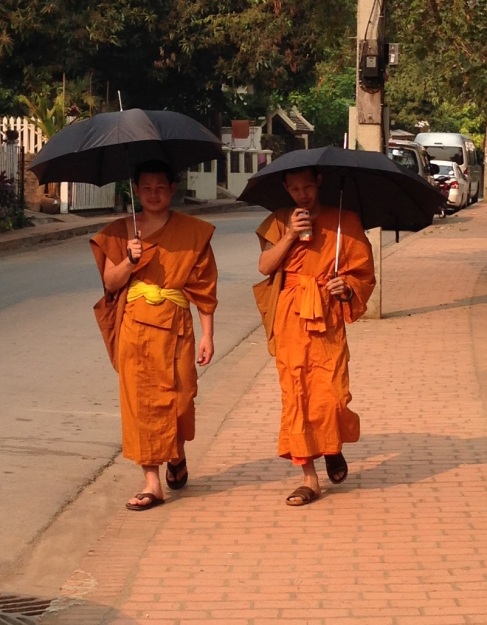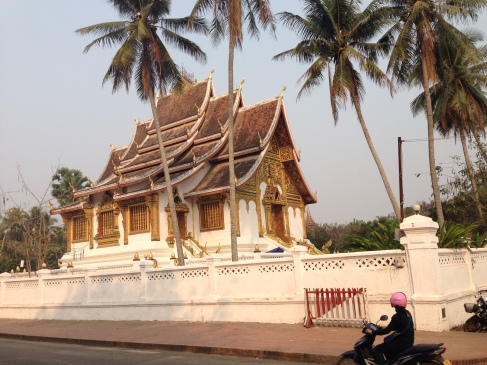Even though I am now safely and happily back home in Vermont, there are a few topics related to my recent trip to Luang Prabang, Laos I’m still researching. One of them is the prevalence of Buddhist temples and monks there. Of all of the items I posted on Facebook during my trip, the photos of monks in saffron colored robes were the most “liked.”
It turns out that the city of Luang Prabang gets its very name from Buddhism. Luang means “land” and “phra bang” means “golden Buddha” in Lao. It was changed to this name more than 300 years ago, after Cambodia gave a gold statue of the Buddha as a gift to the city. At that time, the city was the center of Buddhism for the entire region.
According to a Luang Prabang legend mentioned here by USESCO, “the Buddha smiled when he rested here for a day during his travels, prophesying that it would one day be the site of a rich and powerful capital city.” In case you’re wondering how they knew Buddha had stopped by, one of the temples built into the mountainside has Buddha’s footprint on display!
The type of Buddhism in Laos is unique. It is an offshoot of the Theravāda Buddhist tradition which is the oldest Buddhist branch and considered to be the most conservative. There are over 150 million followers worldwide of the Theravāda Buddhist branch.
In Laos, however, Buddhist beliefs are intertwined with native Animism. One prevalent element of Animism is the idea that there are spirits that influence health and prosperity. Many of the offerings the Lao make at Buddhist temples are accompanied by requests to these spirits to make a positive influence in their lives or to reverse something negative. There are Buddhist statues of countless varieties, each with a different meaning.
It is estimated that 65% of the Lao population is Buddhist. And, when you take into consideration the Animism component, closer to 90% of the population are “nominal adherents of both Buddhism-Animism” (more info is here).
Shortly after our arrival in Luang Prabang, I was so excited to capture this photo of two monks walking down the street in front of our guest house, thinking that it was a rare sight:
Little did I know that monks are quite literally everywhere in Luang Prabang. There are 32 Buddhist temples and more than 1,000 monks that serve the city. Because of the UNESCO World Heritage Site status, the temples are in excellent condition and most have already been restored to their original condition.
Perhaps the most incredible experience from my entire trip was the morning I took part in the procession of the monks. Called “tak bat” or morning alms-giving, all of the monks that serve the local temples leave their temples before 6am and walk through the main streets to receive alms from the devout who line the street.
According to an article on About.com by Michael Aquino: “The ritual is done in silence; the almsgivers do not speak, nor do the monks. The monks walk in meditation, and the almsgivers reciprocate with respect by not disturbing the monk’s meditative peace. For hundreds of years, the ritual has cemented the symbiotic relationship between the monks and the almsgivers who maintain them – by feeding the monks and helping the laypeople make merit, tak bat supports both the monks (who need the food) and the almsgivers (who need spiritual redemption).”
Due to jet lag, I was awake every morning before sunrise. Therefore, walking the 3 blocks from our guest house to watch the procession was a no-brainer. Before I was even able to register that I was in the right location, I came under the powers of an authoritative and industrious local woman who directed me to take off my shoes, sit cross-legged on a mat, and pay 50,000 kip ($6.25) for sticky rice and crackers to give the monks.
After giving alms to three groups of monks, I was out of food and decided to put my shoes back on and take photos of the rest of the procession. Within half an hour, I had seen at least 10 groups of monks stream past, with no end in sight. Satisfied that I had both observed and taken part in something really special, I sauntered off in the direction of our guest house, in search of a strong cup of Laotian coffee.
Doing research for this post, I discovered that the original name for the entire Luang Prabang region was Lan Xang, which means “one million elephants.” That is probably going to be my next topic. Stay tuned.















What an awesome adventure and an excellent job in writing about it. I have to admit, I am thoroughly enjoying reading about your trip.
What an intriguing story! I’m learning so much I never knew about this fascinating part of the world. Thanks, Sharon!
>
fantastic………… C
I just got out of a Zen memorial service so your post was very timely ! G